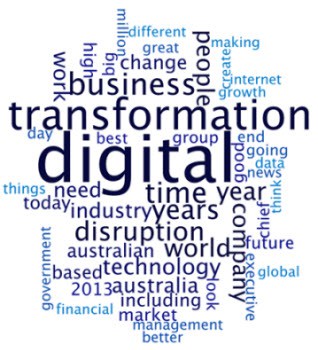Gartner, IDC and Forrester on the Future of Digital Transformation
 Gazing intensely into their respective crystal balls, Gartner, IDC, and Forrester have come up with predictions for 2016 and beyond, highlighting digital transformation and its impact on businesses and consumers worldwide.
Gazing intensely into their respective crystal balls, Gartner, IDC, and Forrester have come up with predictions for 2016 and beyond, highlighting digital transformation and its impact on businesses and consumers worldwide.
According to Forrester, only 27% of today’s businesses have a coherent digital strategy that sets out how the firm will create customer value as a digital business. Gartner says, however, that 125,000 large organizations are launching digital business initiatives now and that CEOs expect their digital revenue to increase by more than 80% by 2020. IDC expects that the percentage of enterprises creating advanced digital transformation initiatives will more than double by 2020, from today’s 22% to almost 50%.
IDC predicts the emergence of the “DX (digital transformation) economy,” Gartner talks about the rise of the “algorithmic business” and the “programmable economy,” and Forrester charts a roadmap for companies responding to digitally savvy customers and consumers. Based on their predictions, here are 3 strategic trends and 3 sets of technologies – big data analytics, Internet of Things (IoT) and Artificial Intelligence (AI) – that will drive digital transformation for the balance of this decade.
Digital transformation will become the key strategic thrust for most CEOs
In 2016, CEOs will make a concerted effort to integrate the various digital initiatives across the business and create a clear digital vision that shows how the business will deliver revenue-generating digital experiences. B2B industries will start to close the digital gap with their B2C peers as they too are confronting rapidly rising customer expectations. By 2018, 67% of the CEOs of Global 2000 enterprises will have digital transformation at the center of their corporate strategy.
Digital transformation initiatives will be consolidated into one vision and function
In 2016, CEOs will make a concerted effort to integrate various digital initiatives across the business and create a clear digital vision that shows how the business will deliver revenue generating digital experiences. By 2017, 60% of enterprises with a digital transformation strategy will deem it too critical for any one functional area and create an independent corporate executive to oversee the implementation.
Digital transformation will require new skills and a shift in IT investments
By 2018, 35% of IT resources will be spent to support the creation of new digital revenue streams and by 2020 almost 50% of IT budgets will be tied to digital transformation initiatives.
Access to talent and the ability to hire the right people at the right time and place will become a big competitive differentiator. Enterprises pursuing digital transformation initiatives will more than double the size of their software development teams by 2018, focusing new hires almost entirely on digital initiatives. Digital skills like mobile app development, analytics, and design thinking will become the new normal for software development.
A greater reliance on digital will bring new challenges: The typical IT organization will spend up to 30% of its budget on risk, security and compliance by 2017, and will allocate 10% of IT staff to these functions.
Big data analytics will serve as the foundation of digital transformation
Embedded data analytics will provide U.S. enterprises $60+ billion in annual savings by 2020. While some enterprises will continue to drown in big data, others will use it to deliver personalized services, and will use emerging classification and analysis tools to find new insights in the data deluge.
Successful digital transformation will be based on establishing data streams in and out of the enterprise and finding new ways to monetize them. Data analytics will be embedded in all new apps, with a specific focus on automating actions based on real-time data analysis.
The Internet of Things (IoT) will be a catalyst for the expansion of digital transformation to all corners of the economy
Greatly expanding the range of digital interactions between consumers and enterprises and the scope and range of data creation, the Internet of Things (IoT) will serve as the growth engine of digital transformation.
By 2018, there will be 22 billion IoT devices installed, driving the development of over 200,000 new IoT apps and services. Also in 2018, six billion connected things will be requesting support and responding to service requests from things, creating new service businesses. In five years, 1 million new devices will come online every hour. IoT devices and solutions have the potential to redefine competitive advantage in every type of economic activity and fundamentally alter how consumers interact with enterprises and how enterprises interact with their supply chain and distribution partners.
Artificial Intelligence (AI) will drive new digital transformation revenue streams
Over the next few years, we will see a shift in focus for digital transformation initiatives from gathering and mining data to creating new models and algorithms that augment work activities and support consumers when they shop, trade, and make decisions.
By 2018, at least 20% of all workers will use automated assistance technologies to make decisions and more than 3 million workers worldwide will be supervised by a “robo-boss.” By 2020, autonomous software agents outside of human control will participate in 5% of all economic transactions. Read More…


